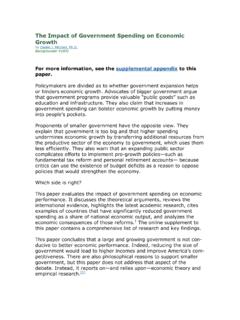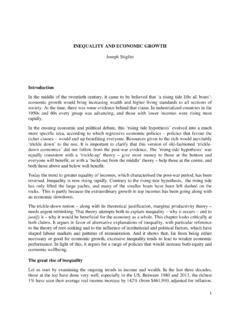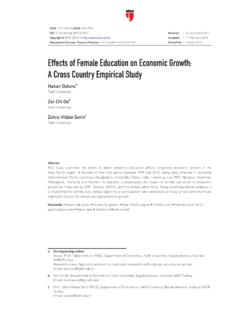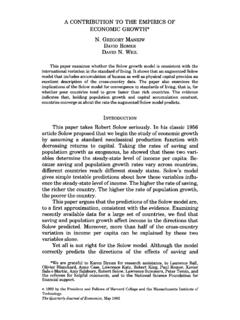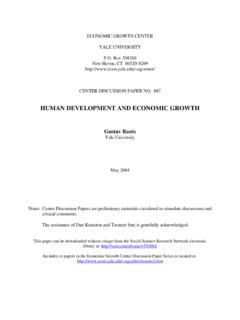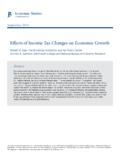Transcription of THEORIES OF ECONOMIC GROWTH - INSEAD
1 THEORIES OFECONOMIC GROWTHbyR. U. AY S*97/13/EPSThis working paper was published in the context of INSEAD 's Centre for the Management of EnvironmentalResources, an R&D partnership sponsored by Ciba-Geigy, Danfoss, Otto Group and Royal Dutch/Shell andSandoz AG.* Sandoz Professor of Management and the Environment at INSEAD , Boulevard de Constance, 77305 Fontainebleau Cedex, working paper in the INSEAD Working Paper Series is intended as a means whereby a faculty researcher'sthoughts and findings may be communicated to interested readers. The paper should be consideredpreliminary in nature and may require at INSEAD , Fontainebleau, of ECONOMIC GrowthRobert U. AyresCenter for the Management of Environmental ResourcesINSEADF ontainebleau, FranceFebruary 1997 AbstractThis paper is a review of the current state of the theory of ECONOMIC GROWTH .
2 It concludesthat the theory is gravely deficient, both in terms of underlying ECONOMIC assumptions (micro-foundations) and naive treatment of technology. The dominant neo-classical theory is basedon the self-contradictory assumption that the economy grows while in a state of Pareto-optimal competitive equilibrium driven by exogenous technical change. The so-called "new"theory of endogenous GROWTH replaces this by the assumption that capital is really free-floatingknowledge that is a public good available to all. Since both assumptions are inconsistent withhistorical and current reality (as well as common sense) a new theory, based on more realisticassumptions, is badly needed. The new theory should explicitly reflect, among other stylizedfacts, the phenomenon of learning by doing and the existence of productive knowledge thatis a private good.
3 It should also reflect the fact that new technologies create new sectors thatgrow, develop, and mature at different times and rates according to a characteristic life U. Ayres THEORIES of ECONOMIC GROWTH File printed oo February 5, 1997 Page 2 The Historical BackgroundIt is too often forgotten that ECONOMIC GROWTH has been a relatively episodic phenomenonin human history. Modest periods of real GROWTH occurred at various times in the more distantpast, but GROWTH that took a century in the late middle ages is now compressed into a decade,or even a single year. What has changed? Is the change irreversible?According to ECONOMIC historian Angus Maddison, ECONOMIC GROWTH between 500 ADand 1500 AD averaged per year or 10% per century [Maddison 1982].
4 1 From 1500 to1700 GROWTH in western Europe accelerated fourfold. At the beginning of that period Spainwas the wealthiest country of Europe, thanks to its American colonies and the gold and silverthey produced. But within a century Spain was declining, in relative terms, and the Dutch hadtaken the lead based on trade. Elizabethan Britain and France under Henry IV, too, grewrapidly from the mid 16th century on, overtaking the Dutch thanks mainly to superior navalprowess. After 1700 or so France became the ECONOMIC leader of Europe for a time, underRichelieu, Louis XIV and Colbert, while Britain was suffering from Civil War and itsaftermath. But the French economy collapsed after the death of Louis XIV, due to excessivedebt and the financial madness that followed John Law's visionary debt privatization scheme(the Mississippi Company) coupled with the incompetence of the 1700 GROWTH accelerated to per year, in the 18th century.
5 Great Britainachieved a GROWTH rate of 1% per year throughout the 18th century, becoming the richestcountry in the world by virtue of stable government, sober financial management (after 1720)and major technological innovations in steam power, iron smelting, cotton textiles, andmachine tools, followed (in the 19th century) by steam railways, steamships and steel. Yetthe period of British ECONOMIC supremacy lasted less than a century. By 1880 or so Britainhad lost its leadership in industrial productivity and output per capita to the By 1900 Germany, too, had passed Britain industrially. Britain did not stop growing but others grewfaster. A few years ago even Italy had surpassed Britain in GNP per rise and (relative) fall of leading economies is an important feature of the overallpattern.
6 But another feature is a general acceleration. Leading economies have typicallypeaked and faltered, while followers have typically achieved still higher GROWTH rates (for atime) before faltering in their turn. In contrast to previous centuries, a number of countrieshave sustained GROWTH rates of more than 10% per year for a decade or even two. Japanmanaged to keep it up through the 1960s and 1970s. Taiwan and Korea have done as wellor better in the 1970s and 1980s. Malaysia, Indonesia and Thailand followed by a few recently, China has grown very rapidly throughout the 1990s and the Philippines seempoised to follow the Japanese economy has come to a virtual standstill in the 1990s. South Koreangrowth has slowed from 10% per annum to around 6% now.
7 The pattern the recent surge of ECONOMIC GROWTH , which began two centuries ago (and is stillaccelerating in some parts of the world) continue indefinitely? To what do we owe this "greatleap forward"? THEORIES of ECONOMIC GROWTH (and, for that matter, THEORIES of trade) are onlyone small part of neoclassical economics. But GROWTH is such an important phenomenon thata good theory is a vital prerequisite of policy. Unfortunately, it must be said that if a "good"theory is one that allows predictions with an accuracy significantly better than random, nosuch theory , this fact has never stopped economists from recommending policies on the basisof poor THEORIES , sometimes in the strongest possible terms.
8 Not infrequently, in the past, therecommended policies have turned out disastrously. But this has had little impact on thedefenders of established theory, in all epochs. Today no less than in the U. Ayres THEORIES of Eeenerek GROWTH File GROVITILTXTas printed on February 5, 1997 Page 3 - The basic idea of GROWTH theory until the 1950s has been that the drivers of economicgrowth are labor, land and capital. The labor force is assumed to be (roughly) proportionalto population. Beyond this, the relationship is seldom explored more deeply. Land was theonly form of capital considered at first, it being a surrogate for all natural resources. Later,the importance of man-made capital had to be recognized and included.
9 Gross output, then,depends on "factors of production", usually identified as labor, capital and land or resourceinputs. The output is generated from inputs by a "production function", which may or maynot be given explicit mathematical the 19th century good data was scarce, hence quantitative analysis was it was clear that both population and land inputs were increasing. The latter, ofcourse, was attributable to the opening up of the American continents to , by the late 19th century the input of new land was no longer significant, yeteconomic output per capita was rising rapidly; in fact, more rapidly than ever before inhistory. This fact led the economists of the time to conclude that the accumulation of man-made capital must be the critical factor driving ECONOMIC GROWTH .
10 Also, the relatively fewgiant corporations of the late 19th century like Carnegie Steel, Dupont, Standard Oil andthe major railroads were owned directly by wealthy entrepreneurs, not by impersonalfinancial institutions. Thus, it did not seem necessary to distinguish corporate profits frompersonal GROWTH models invariably include other relationships (without which they would beindeterminate), such as assumed models of the rate of labor force ( population) GROWTH , therate of capital accumulation ( investment less depreciation) and the rate of natural resourcedepletion. Investment is often equated with savings an assumption that is more convenientthan problem of GROWTH was addressed by Karl Marx.


